Woodpeckers
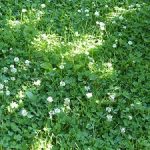
Soft and fragrant underfoot, clovers naturally fix nitrogen in our lawns.
A man whom Rich hadn’t seen for years recently approached him in a parking lot. “You once wrote a newspaper column suggesting that people not spray their yards for insects or weeds. We took your advice and magic happened,” he said.
He explained that a couple of years after he stopped spraying, white clover appeared in the yard and fireflies graced the evening darkness. “We’re enjoying both,” he added.
A major problem with poison sprays is that they aren’t usually selective. Often people spray to rid their lawn of grubs without realizing they also are killing fireflies, pollinators, and a host of other interesting and beneficial insects and the animals that dine on them. If you poison dandelions, you also kill clover that fixes nitrogen naturally and a wide range of other flowering plants that add diversity to the lawn and buffer it from unusual growing conditions.
What child has not delighted in chasing fireflies on a warm summer evening and, perhaps, catching a few to watch light up the inside of a glass jar? In fact, an adult friend who grew up on the eastern plains of Colorado was enchanted with them when she visited Iowa one summer. Fireflies, or lightning bugs, are common across much of the Eastern United States. Some blink yellow while others green, but whichever color they blink it is probably an effort to seek a mate. Some firefly species live in the West, they just don’t glow! The larvae, sometimes called glow worms often live in rotting wood where they seek insect prey.
To enjoy an evening firefly display leave edges and corners of your yards unmowed. Perhaps position some wood there to gradually rot and provide homes for their larvae. Certainly avoid insecticide spray!
CLOVER
Many species of clover are common across much of North America but the one most often found in unsprayed yards is the White Clover. It can be planted but usually just avoiding herbicides for a few years will encourage it to move in on its own. Clover blooms provide wonderful pollinator food while sprinkling a lawn with attractive white flowers. The plant is a legume, meaning that it is able to fix nitrogen and improve soil health – naturally! Why anyone would want to kill such a valuable and beautiful plant is beyond us.
Sometimes the very best lawn and yard management is simply leaving it alone. Stop spraying and the result is likely…….beauty.
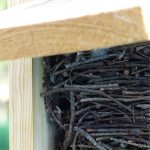
The wrens use just their beak and claws to layer sticks and then feathers from other birds to make a cozy safe nest to raise young.
Just ten days ago the wren parents fledged the babies from the box on our deck. After we knew they were safely gone, Rich unbolted and cleaned out the next. What an amazing feat of engineering! With just a beak and claws, the wrens fashioned a comfy, warm home to sit on eggs and raise young. All was quiet for the rest of the week. The birds had all dispersed.
The past few days we have noticed activity in the High Bush Cranberry, on the deck, around the pond and at the feeders. Today, definite mating activity as up to five wrens competed for attention, displayed mating moves and two began rebuilding the box on the deck. In and out flew the wren gathering small sticks by the pond and placing them in the box. So, it looks like a pair plans to start one more brood.
Later in the year, the Carolina Wren will grace our yard. Larger and more distinctive, it seems to fare well in Iowa even in cold weather.
Late June into mid-August is exciting, dangerous and nostalgic for all creatures fledging – including people!
Birds and wild creatures have mated, nested, and are raising young. For some this takes weeks, months or years (kids). This spring has been fun watching the rabbits and variety of birds growing up and fledging. At the same time, Marion has been reading the Jean Craighead George series: My Side of the Mountain, The Far Side of the Mountain, and Frightful’s Mountain. About experiencing the power of observation as nature unfolds.
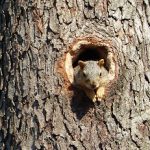
It’s a long way down, Mom.
A squirrel family nested in a hole in an oak within view of the back deck. One spring day we spotted a young squirrel just looking out. Soon after, we saw young in all the fruit trees hanging upside down. We think that their dexterity must be developed in part by their having been gestated in the moms leaping from branch to branch and raised in wind whipped trees.
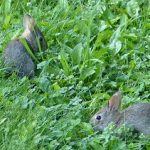
Bunnies are on their own as soon as the mother weens them.
Recently, Rich spied a young rabbit family nest under a maple tree. This spring most ground reared animals like bunnies, turkeys and pheasants were safe from storms. So, the rabbits are prolific! They are hilarious to watch in different stages of growth from naive hand sized bunnies to teen-sized rabbits to adults. They often hold convention on our front and back lawns. They seem alert and always near tall grass because the owl population has grown – we hear them hooting at dusk.
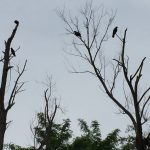
Crow family fledging
Crows suddenly seem to appear yet they have been around all the time. In tall trees a family hangs out watching for food. On the ground you can tell the adults and young by watching who feeds whom. At some point the adults say, “You are on your own!” Off they fly and the young have to survive.
Wrens and Cardinals are always a treat to watch. The one nest off our back deck gave us great viewing as the pair bonded, set up home, fed each other as one sat on eggs, and the babes grew from a chittering brood to fully fledged and out of the nest in a matter of weeks. Now the box and deck are strangely and sadly quiet. But, the fledglings frequent the shrubs nearby, still entertaining us.
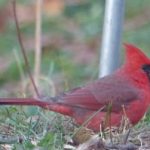
Cardinal on Ground
Cardinals are perhaps my favorite only because I watched a family grow and fledge the same time our daughter graduated and left for college.
All the animals are amazing to watch. They are smart, adaptable and instructive. We learn a lot watching them. By next spring their numbers will be decreased as many die from predation, accidents, weather and interactions with humans. Meanwhile, keep your eyes and ears alert for these incredible creatures with whom we share this ecosystem.
Take in some great summer reading! Cornelia (Connie) Mutel, Winding Pathway’s good friend, sent us her most recent book, A Sugar Creek Chronicle: Observing Climate Change from a Midwestern Woodland.
Her book weaves three themes together that encourage readers to enjoy woodlands and embrace actions to lessen climate change.
Connie is a gifted nature writer who transforms her observations into delightful prose that reminds us of Joseph Wood Krutch‘s style. Her book is a pleasant way to learn about and enjoy a woodland as it progresses through seasons and responds to weather.
As the title implies, she relates changes in her woods caused by climate change. Nature is neither politically correct nor untruthful. A knowledgeable observer, as the author is, recognizes alarming signals of a warming planet communicated by vegetation and wildlife but often unnoticed by those less informed.
Finally, she weaves her personal story into a blend of woodland delight and climate concern. She bemoans her reliance on fossil fuel to get to and from work and to run her air conditioner, expresses joy at sharing woodland hours with grandchildren, and relates her long term cancer relationship with earth health.
Sugar Creek Chronicle is a lovely book about a serious environmental threat. Perhaps its major virtue is how the author blends joy of nature’s beauty, concern about the planet’s future, and a love of life that encourages readers to lessen the impact of climate change.
University of Iowa Press Bur Oak Series
www.uiowapress.org
ISBN: 978-1-60938-395-4
Marion’s all time favorite summer series is by Jean Craighead George: My Side of the Mountain, The Far Side of the Mountain, and Frightful’s Mountain.
Other good books to read this summer:
The Intelligent Optimist”s Gide to Life. Jurriaan Kamp. Berrett-Koehler Publishers, Inc. 2014. ISBN: 978-1-62656-275-2
Places of Quiet Beauty: Parks, Preserves and Environmentalism. Rebecca Conrad. University of Iowa Press. ISBN: 0-87745-558-9
Their Name Is Today: Reclaiming Childhood in a Hostile World. Johann Christoph Arnold. Plough Publishing House. ISBN: 978-0-87486-630-8
We are proud of and fortunate that our yard is home to a wide array of fascinating plants and wildlife.
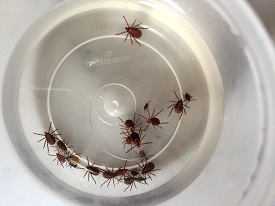
Only a good friend would know that we want pictures of creepy crawlies and save them for us for our blog!
But, last year Rich encountered a wild animal that he wishes he’d avoided. A deer tick found and bit him, although he never saw the tiny eight legged creature. A classic symptom of Lyme Disease is a red rash shaped like a bull’s eye. But Rich never had one. Instead he became overwhelmed with lethargy.
“I never felt sick, just tired, and kept thinking I’d be fine in a day or two,” he said.
But the fatigue dragged on for months, so he called our family physician who urged him to come right in. She gave him a thorough check over, and prescribed a chest X Ray and a Lyme Disease blood test.
Rich did both that afternoon. Within hours the doctor called to say the X ray revealed pneumonia and prescribed an antibiotic. Four days later the Lyme test came back positive and she prescribed a 21 day regime of amoxicillin, a different antibiotic.
“In just a few days the medicine worked and I felt better. Within a month the fatigue evaporated and the only lingering symptom was mild knee pain that may or may not have been caused by Lyme. I’m 66 and have a bit of osteo arthritis,” he said.
Rich was lucky. A year after the Lyme diagnosis he’s doing fine. Fortunately, his doctor prescribed the correct tests and medication and caught the disease early. Many people are less fortunate and suffer long term pain, fatigue and other symptoms.
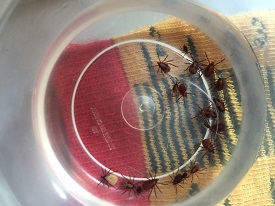
Ticks measured against eighth inch markings.
Lyme disease is transmitted by the deer tick, a tiny eight legged animal that is increasingly common. Ticks live in tall grass and brushy areas, and our yard at Winding Pathways has both. We walk through other places where a tick could have found Rich. Ticks usually crawl around on a person for several hours before digging through the skin and feeding on blood. A wandering tick that has not penetrated the skin cannot transmit disease. Pluck it off and flush it down the toilet or drop it into soapy water.
It’s easy to be scared by negative publicity about Lyme Disease and stay inside. While the disease is serious and is not to be taken lightly, advice to avoid brushy and grassy places must be put into context. These places are beautiful and are homes to interesting wildlife and plants. They are places to get exercise. Even after contracting Lyme we spend part of our time in tick habitat, but we are cautious.
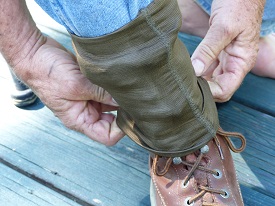
Gaiters fit snugly over boots and pants to deter ticks.
Here’s what we now do:
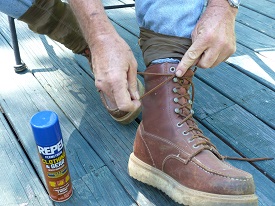
Permethrin-based spray can be bought at most stores that sell insect repellent.
We spray the gaiters with special repellent containing Permethrin that both repels and kills ticks Apply this to clothing, not skin. It is effective for at least two weeks so we don’t launder the gaiters but reapply the spray a couple of times a month.
Rich emerged from Lyme Disease cautious and smarter but not afraid of being outside in beautiful and interesting places.
FOR MORE INFORMATION
The Internet has great information on ticks and Lyme Disease.
Two of our favorite information sites are:
Centers for Disease Control and Prevention.
WebMD type in the search bar Lyme Disease.
We ordered our tick and chigger gaiters from Forestry Suppliers.
Permethrin based spray can usually be purchased in stores that sell insect repellent. Be sure to read the label.